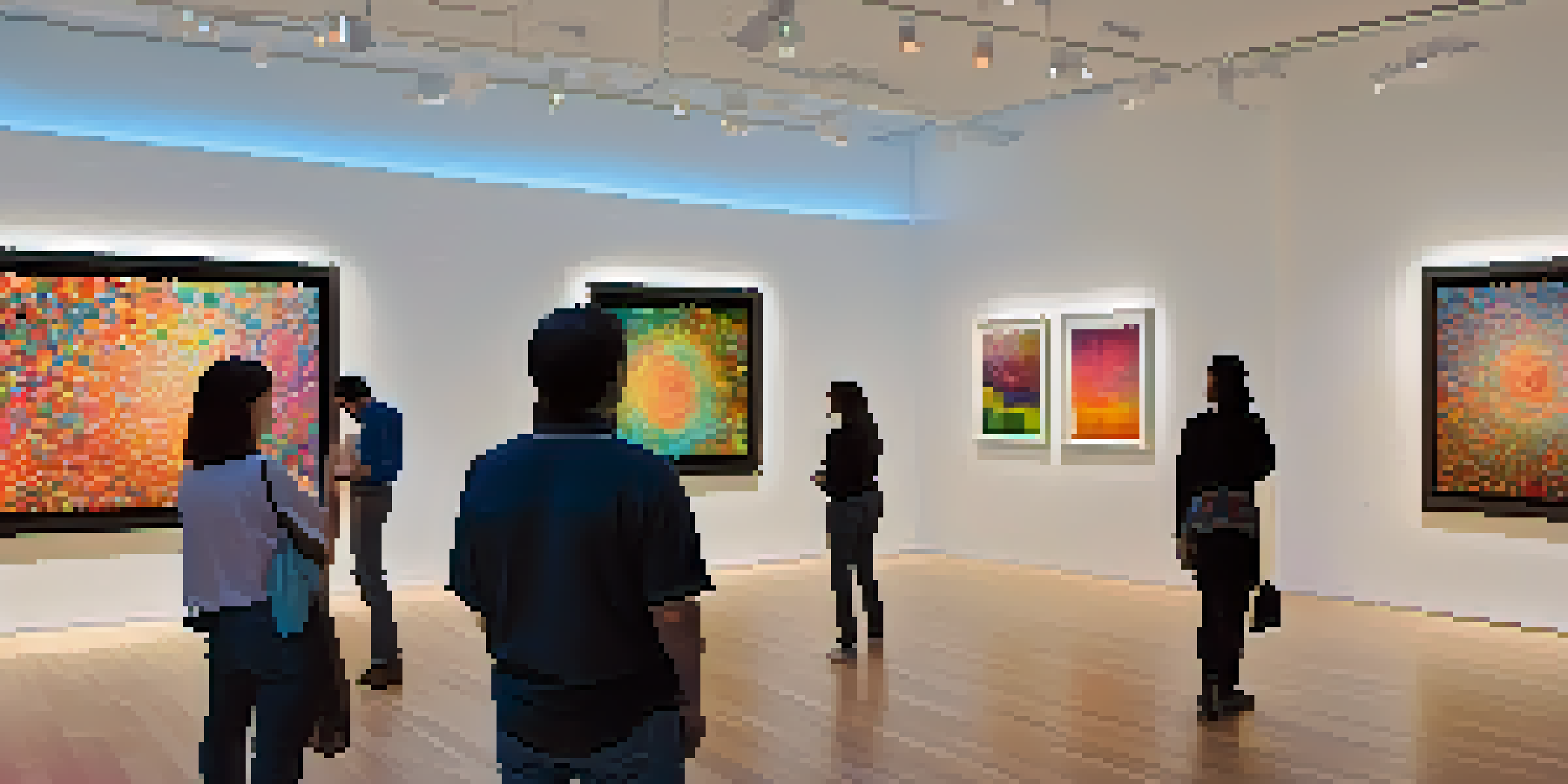Case Studies: Successful Art Sales Using Cryptocurrency

Introduction to Cryptocurrency in the Art World
In recent years, cryptocurrency has made a significant impact on various industries, and the art world is no exception. Artists and collectors are increasingly exploring digital currencies as a means to buy and sell art, offering a new level of convenience and security. This shift not only attracts tech-savvy buyers but also opens up a global marketplace for art transactions.
Every revolution starts with a spark. In the art world, that spark is cryptocurrency.
Using cryptocurrency allows for faster transactions, lower fees, and greater transparency. For instance, artists can receive payments directly, bypassing traditional galleries that often take hefty commissions. This direct interaction fosters a more personal relationship between artists and collectors, enhancing the overall experience.
Moreover, the use of blockchain technology in art sales ensures authenticity and provenance. Each transaction is recorded on a decentralized ledger, making it nearly impossible to forge or misrepresent ownership. This level of security is particularly appealing in a market where authenticity is paramount.
Case Study: Beeple's Digital Artwork Sale
One of the most notable examples of successful art sales using cryptocurrency is Beeple's digital artwork, 'Everydays: The First 5000 Days.' This piece was sold at a Christie's auction for a staggering $69 million, making it a landmark moment for digital art. The buyer, who purchased the artwork using Ethereum, showcased how cryptocurrency can facilitate high-value transactions in the art world.

Beeple's sale not only demonstrated the potential of cryptocurrency but also highlighted the growing acceptance of digital art as a legitimate form of artistic expression. The sale sparked conversations around the value of NFTs (non-fungible tokens), which are unique digital assets that can represent ownership of digital art.
Cryptocurrency Transforms Art Sales
The integration of cryptocurrency enables faster transactions, lower fees, and greater transparency in the art market.
This case study serves as an inspiration for artists and collectors alike, showing that cryptocurrency can elevate the art market to new heights. The success of Beeple's sale has encouraged more artists to explore digital mediums and engage with cryptocurrency for their transactions.
Case Study: The First NFT Gallery Sale
In another groundbreaking event, the first NFT gallery sale took place in 2021 at the 1-54 Contemporary African Art Fair. The gallery showcased various African artists, allowing them to sell their works as NFTs through cryptocurrency transactions. This event not only promoted African art but also embraced the digital revolution in the art sector.
Art is the most beautiful of all lies; cryptocurrency can make those lies infinite.
By allowing artists to list their works on a blockchain platform, the gallery ensured that both the artists and buyers benefitted from reduced fees and increased transparency. The success of this gallery sale demonstrated that cryptocurrency could provide a viable alternative to traditional art sales methods.
Furthermore, this case study illustrates the importance of inclusivity in the art world. By adopting cryptocurrency and NFTs, galleries can support a diverse range of artists while reaching a global audience, empowering creators from different backgrounds.
Case Study: CryptoPunks and the Rise of Digital Collectibles
CryptoPunks, a collection of 10,000 unique digital characters created by Larva Labs, has become a phenomenon in the art world. These pixelated avatars were initially offered for free but have now sold for millions of dollars, with some fetching prices over $11 million. The popularity of CryptoPunks illustrates the immense potential of digital collectibles in the cryptocurrency space.
The sales of CryptoPunks have attracted a new wave of collectors who view these digital assets as both art and investment opportunities. By leveraging the Ethereum blockchain, each CryptoPunk is verifiably unique and owned by an individual, which adds a layer of exclusivity that traditional art sometimes lacks.
Successful NFT Art Case Studies
Notable examples like Beeple's sale and the first NFT gallery sale demonstrate the growing acceptance and potential of digital art.
This case study highlights how cryptocurrency is reshaping the concept of ownership in art. Collectors are no longer confined to physical pieces; they can invest in digital art that holds value and significance within the growing crypto community.
Case Study: Art Blocks and Generative Art Sales
Art Blocks is an innovative platform that allows artists to create generative art pieces stored on the Ethereum blockchain. Each piece is generated algorithmically at the time of purchase, making every transaction a unique experience. This model has attracted collectors eager to explore the intersection of art and technology.
The success of Art Blocks showcases how cryptocurrency can facilitate new artistic movements. Artists can monetize their work directly on the platform, and collectors can buy pieces with the assurance of authenticity and ownership. This democratization of art sales encourages creativity and experimentation.
Moreover, Art Blocks has fostered a vibrant community of artists and collectors who share a passion for generative art. This collaboration has led to successful sales, demonstrating that cryptocurrency can create not just transactions, but also connections within the art world.
Challenges and Considerations in Crypto Art Sales
While the success stories of art sales using cryptocurrency are compelling, there are challenges to consider. The volatility of cryptocurrencies can pose risks for both artists and collectors. Prices can fluctuate dramatically, leading to uncertainty in the value of art sold in digital currencies.
Additionally, the environmental impact of cryptocurrency mining has raised concerns among artists and collectors alike. As awareness of climate change grows, some are reevaluating their involvement with platforms that rely on energy-intensive mining processes. This has prompted discussions about more sustainable alternatives within the crypto art space.
Challenges in Crypto Art Market
Despite the benefits, volatility and environmental concerns pose significant challenges that artists and collectors must navigate.
Despite these challenges, many in the art community remain optimistic. By addressing these issues head-on, artists and collectors can navigate the complexities of the crypto art world while embracing its potential for innovation and growth.
The Future of Art Sales with Cryptocurrency
Looking ahead, the future of art sales using cryptocurrency appears promising. As more artists and galleries adopt digital currencies, we can expect to see an increased demand for crypto-based transactions. This trend may lead to a shift in how art is valued and sold, with digital assets gaining more recognition.
Furthermore, advancements in technology could enhance the user experience for both buyers and sellers. Platforms that simplify the process of buying and selling art with cryptocurrency will likely emerge, making it even easier for artists and collectors to engage in this new marketplace.

Ultimately, the integration of cryptocurrency into the art world represents a transformative shift. As artists continue to push boundaries and explore new mediums, the landscape of art sales will evolve, offering exciting opportunities for all involved.
Conclusion: Embracing Change in Art Sales
In conclusion, the case studies presented highlight the successful integration of cryptocurrency into the art world. From high-profile sales to innovative platforms, the potential for growth and creativity is immense. As more artists and collectors embrace this digital revolution, the landscape of art sales will continue to evolve.
While challenges remain, the benefits of using cryptocurrency for art transactions are undeniable. The ability to foster direct relationships, ensure authenticity, and reach a global audience opens doors to a future where art can thrive in a digital economy.
As we move forward, embracing change and exploring new possibilities will be crucial for artists and collectors alike. The journey of integrating cryptocurrency into art sales is just beginning, and the results could reshape the way we think about art and ownership.